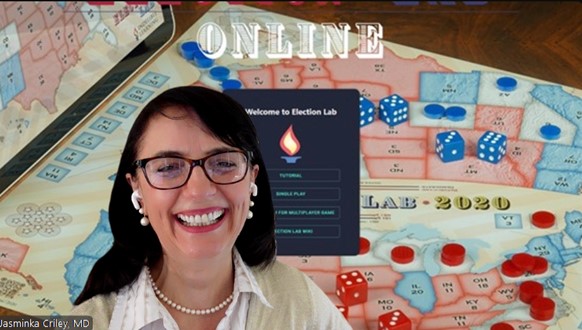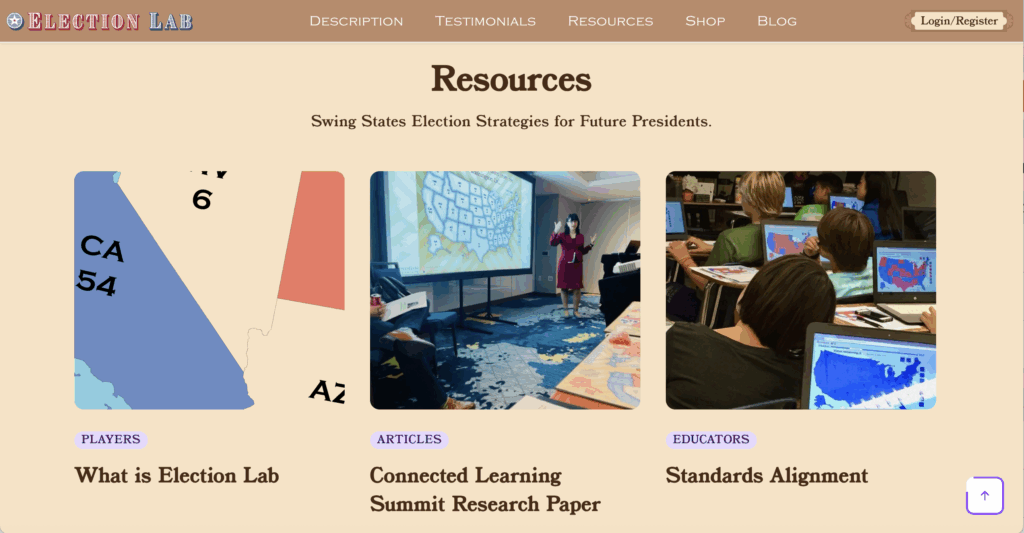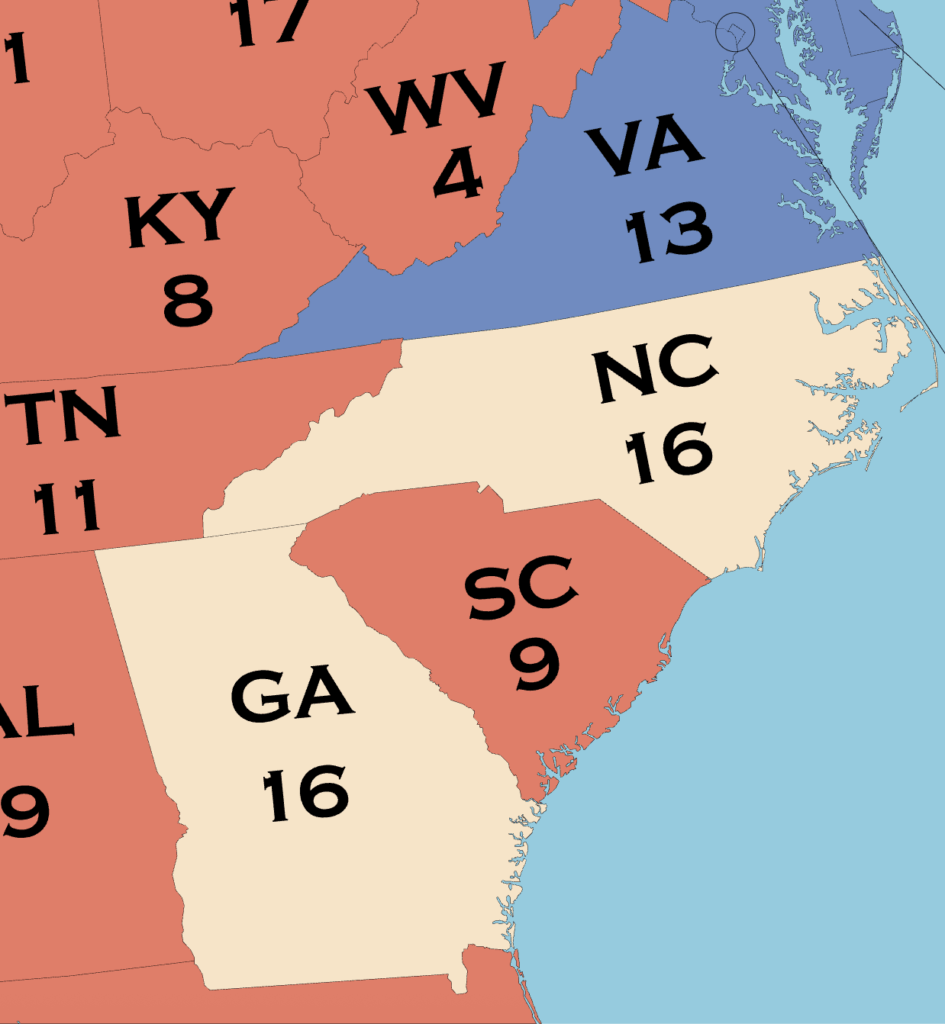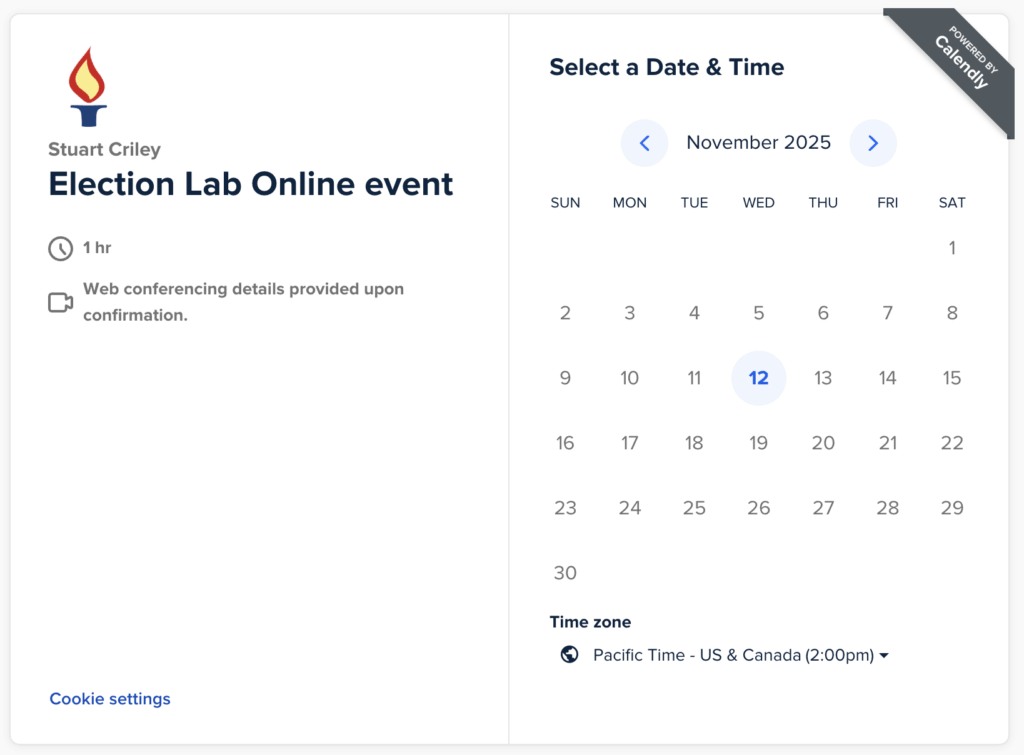On October 15, 2025, players gathered once again for the Election Lab Online event. This is our monthly online Electoral College strategy simulation event. During the online play, participants face off in one-on-one matchups. They craft electoral campaign strategies and battle for the ultimate prize: winning the U.S. presidency.
Once again, we transformed a virtual room full of strategists into presidential contenders. Some of ELO’s old friends returned with a continued passion for testing different strategies and enjoying the simulation. New ones joined. And three historic elections, i.e., 2020, 1960, and 2000, came to life in a high-stakes simulation of presidential politics.
Lucas kicked off the event by guiding players through gameplay. He loves strategies. He explained the core game mechanics. Daniel, listening closely, smiled and said, “This is how we should vote for President.”
The night’s breakout star? Cara. A high school student, quiet and focused, who outmaneuvered veteran players and claimed the most electoral votes of the evening.

Round One: The Rollercoaster of 2020
The first simulation, the presidential election of 2020, was pure energy from the opening moments.
“Oof… 1 vs 6 — does it need to be this way?” someone exclaimed as dice rolled, immediately sparking conversations about polling, probability, and strategy.
Daniel was playing Dan Khan, who was deeply in her strategy thoughts and smiling. “I am pulling through”, one of them exclaimed. They continued making insightful comments.
Morgan and David battled down to the last state. Once again, Florida became the unpredictable swing state everyone loves (and fears). Aaron experienced the sting of volatility firsthand:

“I was up 5 to 2, and I lost it! It’s just like real elections: you think you’ve got it, and then… puff!”
Daniel surged early to the top of the leaderboard, looking every bit like the frontrunner. But Cara quietly and methodically stacked her resources on high-value states, as she explained later. She was trying to avoid risky dice rolls and use the event cards she got with surgical precision.
By the end of the round, the leaderboard had shifted.
“How is that possible?” Daniel asked in disbelief. “She’s playing for the first time and winning?”
Round Two: A Tie in 1960
When the table jumped back in time to the election of 1960, Daniel captured the mood perfectly:
“TIME-TRAVELING PRESIDENCY?!”
The older map surprised most players. Daniel scanned the board, visibly recalibrating: “Oh wow… that changes things,” Daniel said. It certainly does. Now, players need to think of different strategies as the electoral map looks so different.
Morgan and Lucas started their duel fiercely. They made some bold moves. Some risky ones. Both were determined to win! Surprisingly, even with a more complicated map, this battle came to the final roll. They held their breath.
“This is the first 1960 TIE ever!” David shouted! They both laughed. Both were amazed at how things played out.
“Being immersed in this online simulation changes everything. It gives you new glasses you did not have before,” as our colleague Tammie Shrader said previously.
It was a historic Election Lab moment: Lucas and Morgan, deadlocked, both laughing at the drama of their simulated “election night.” Meanwhile, Cara remained steady at the top of the leaderboard. Her quiet presence inspired others to try and win.

Round Three: Election Year 2000. A Nail-Biter to the Last State Simulating a Real Election
The third and final election year we played was the Election Year 2000. Like in real life, margins of victory were razor-thin. Electoral battles were every bit as dramatic as the real-world election. Emotions ran high. Event cards flew. Dice rolled. Strategies shifted.
“This is insane,” Aaron mumbled. “I think, well, I think … I can still go for it” he said louder.
Daniel countered, rallying late in the game: “The little states love me!”
States fell one by one. The tension built.
“We are literally at the LAST STATE!” Aaron shouted. The excitement of the unexpected brought the 2000 election simulation to life as well.
As the game play simulations were brought to a close, Cara, calm and focused, secured her final victory.
Leaderboard revealed that she had the most electoral votes: 287.
Post-Game Reflections: Learning Through Play
What Makes This Game Special?
After the last race, David led a thoughtful post-game discussion, moderating as he does so skillfully. Post-game reflections are a hallmark of these sessions, and this one was no exception. These reflection moments are a signature part of Election Lab events. This is the time when gameplay simulation turns into meaningful civic dialogue.
- Daniel praised the unique system: “I really like it. It’s such a unique system. You actually get strategic bounce-back when you lose. That forces new decisions and keeps things fun.”
- Cara noted how the current deployment of resources and game mechanics mirrors real campaigns: “You set the strategy, then watch it unfold.” Sentiment that Morgan shared as well.
- When Morgan played the ELO previously, it did not have the event cards. This is the new feature we added. “Adding the cards was such a brilliant move”, he added. “I can’t imagine the game without them.” Lucas and Dan Khan agreed and pondered other features.
- “Skipping cards is not ideal.” Dan Khan answered someone’s question. “You could have many left over. Not the best strategy.”
- Aaron compared the game’s unpredictability to “Mario Party chaos.” Makes things fun (and chaotic) like in real elections.
- Stuart, the visionary behind this invention, reflected on its realism: “Frontloading strategy mirrors real campaigns.” Furthermore, he added, “States move together. Events ripple. It’s brutal but also fascinating.”

Players also brainstormed additional enhancements. Many of these we already thought of, or we took them out because of deadlines or limited resources. We also discussed transfers between states and political connections between the states. Naturally, the topic of additional mechanics came up, as well as keeping the player agency while keeping unpredictability. And at the core of all this is still our game’s authenticity. Being truly authentic is what we do at Indelible Learning with all our games, simulations, and programs. In this case, maintaining authenticity and, at times, real campaign chaos. And echoing the way real political campaigns adapt (or not) in real time.
Cara’s Winning Strategy
When asked how she pulled it off, Cara didn’t hesitate to share:
“I stacked on only one small state that had maybe 4 electoral votes and put everything else on the big states,” she answered. “That is a legitimately good strategy. “I tried not to do dice rolls on the small ones. And tried to use more cards strategically.”
For a first-time player, her composure and precision were remarkable. It is a reminder that in Election Lab, new contenders can rise fast.
Top Highlights of the Night:
- First-ever tie in the 1960 simulation
- Cara’s breakout victory with most wins and 287 electoral votes
- Daniel’s early leaderboard lead and strong strategic play
- Deep strategy discussions on mechanics and realism
- High engagement, laughter, and “election night” energy throughout
Election years played: 2020, 1960, 2000
Champion: Cara (High School Student)
Closing Thoughts:
A Community of Play, Strategy, and Civic Learning
As the session wrapped, we were grateful for everyone who joined us. It was another amazing event. We are proud of the community we are building. Community of play, strategy and civic learning. I was grateful for my indelible team and their dedication. And it goes without saying, expert execution of another great ELO event. The following day I sent them a Thank You:

- David, for excellent job in moderating the session.
- Lucas for guiding new players with general game overview.
- Aaron, for his expressive and contagious energy.
- Dan Khan, for fierce competition and good humor.
- Stuart for his ingenuity and kindness.
- David, for expertly moderating the post-game reflections.
Overall, this was a lively learning experience. This was more than a game night. It was a shared civic simulation where probability, strategy, and real electoral dynamics collided in a safe, playful space. It was a simulation that sparked critical thinking about probability, electoral college, campaign strategies, and how sometimes, razor-thin margins can decide the presidency.
The next Election Lab Online event is already on the horizon for November. If the October session proved anything, it’s that new players can rise fast, strategy matters, and the Electoral College, no matter what election year, is always full of surprises.
THE END

Dr. Jasminka Vukanovic-Criley MD, FACP, FHM is a multiple award-winning physician, internist, hospitalist, healthcare & education innovator & Associate Clinical Professor of Medicine at UCLA. She is a career mentor & advisor to numerous undergraduate, graduate & postgraduate students & faculty. As a researcher, Dr. Criley received awards from the National Institutes of Health & the U.S. Department of Education Her work focuses on creating research-driven #edtech games & digital media to improve health, civics, science education & promote healthy habits. Dr Criley is also a sought-after speaker & a founding Board member of Physician’s Weekly. She can be reached on X at @criley_md and at www.linkedin.com/in/jasminka-criley-md